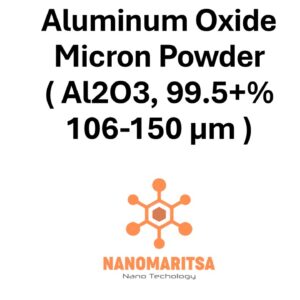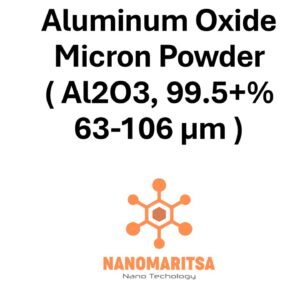Aluminum Oxide Micron Powder (Al₂O₃, 99.5+%, 12–40 µm) is a high-purity alumina powder recognized for its superior hardness, chemical resistance, and thermal stability. With a particle size range of 12 to 40 micrometers, it is optimized for applications requiring coarser particles, such as powder metallurgy, abrasives, coatings, and industrial manufacturing. Its 99.5+% purity ensures consistent performance in demanding environments, making it a versatile material for a variety of industries, including aerospace, automotive, electronics, and energy.
1. Key Properties
High Purity (≥99.5%) The high-purity grade minimizes impurities, ensuring reliability and consistency in advanced manufacturing applications such as ceramics and coatings.
Particle Size (12–40 µm) The coarser particle size enhances flowability and reduces agglomeration, making it ideal for powder-based processes and high-efficiency coatings.
Exceptional Hardness Alumina’s hardness makes it an excellent material for wear-resistant parts, abrasives, and protective coatings, extending the service life of components.
Thermal Stability With a melting point over 2,000 °C, alumina maintains its structural integrity under extreme temperatures, making it suitable for high-heat environments.
Chemical Inertness Alumina’s resistance to acids, alkalis, and other chemicals ensures durability in corrosive environments, making it suitable for use in industrial and chemical processes.
2. Applications
Advanced Ceramics & Refractories Alumina is widely used in high-performance ceramics and refractory materials, including kiln furniture, nozzles, and industrial equipment that requires high temperature and wear resistance.
Abrasives & Polishing The 12–40 µm particle size is ideal for grinding, cutting, and polishing applications, offering a balance of efficiency and surface quality.
Thermal Barrier Coatings Alumina-based coatings are applied to protect components exposed to high temperatures, such as turbine blades, engine parts, and industrial furnace walls.
Electronics & Insulation Alumina’s excellent electrical insulating properties and thermal conductivity make it a key material for circuit substrates, sensor housings, and other electronic applications.
Catalysis & Filtration Alumina supports catalytic reactions and is used in filtration systems requiring high thermal and chemical resistance, such as in petrochemical or environmental processing.
3. Advantages
Improved Flowability The 12–40 µm particle size range promotes efficient flow in powder-based applications, reducing clogging and ensuring consistent feeding in manufacturing processes.
Wear Resistance Alumina’s extreme hardness enhances the durability of tools, coatings, and components exposed to abrasive or high-friction conditions.
High-Temperature Performance Alumina retains its mechanical properties at high temperatures, making it suitable for refractory linings, thermal barriers, and other heat-intensive applications.
Chemical Stability Resistance to aggressive chemicals enhances the longevity of alumina-based products in harsh environments, including chemical processing and industrial filtration systems.
Electrical Insulation Alumina’s dielectric properties make it an essential material for insulating and protecting components in high-voltage or high-temperature electronic systems.
4. Recent Trends and Research
Additive Manufacturing Researchers are exploring the use of coarser alumina powders in 3D printing processes such as binder jetting, enabling the production of larger, complex ceramic parts.
Advanced Coating Technologies Innovations in thermal spray and plasma spray techniques are improving the uniformity, adhesion, and durability of alumina-based coatings.
Optimized Abrasives Efforts are being made to enhance the performance of alumina abrasives, focusing on reducing wear and achieving finer finishes in high-precision applications.
Sustainable Manufacturing Recycling alumina from used abrasives and ceramic scrap is gaining momentum as industries strive for greener production methods and lower material costs.
Energy & Environmental Applications Alumina is being increasingly used in energy storage systems, catalytic converters, and filtration technologies to meet global sustainability goals.
5. Future Prospects
Enhanced Ceramic Fabrication Advances in powder processing and sintering techniques will allow for the production of highly intricate and durable alumina ceramic components.
Next-Generation Coatings Alumina’s ability to protect against extreme heat and corrosion will drive its use in advanced coatings for aerospace, energy, and automotive sectors.
Medical & Bioceramic Applications Alumina’s biocompatibility and wear resistance make it a strong candidate for medical implants, surgical tools, and dental applications.
Lightweight Composites Alumina-reinforced composites are expected to play a greater role in automotive and aerospace industries, offering high strength-to-weight ratios.
Clean Energy Solutions Alumina’s role in filtration, catalysis, and energy storage will expand as the demand for efficient, environmentally friendly technologies increases.
By combining 99.5+% purity with a 12–40 µm particle size range, Aluminum Oxide Micron Powder (Al₂O₃, 99.5+%, 12–40 µm) delivers the durability, thermal stability, and wear resistance needed for high-performance applications. Whether used in ceramics, coatings, abrasives, or electronics, alumina continues to be a cornerstone material for cutting-edge industries.
| Measurement (gr) | 100 grams, 500 grams, 1000 grams |
|---|






